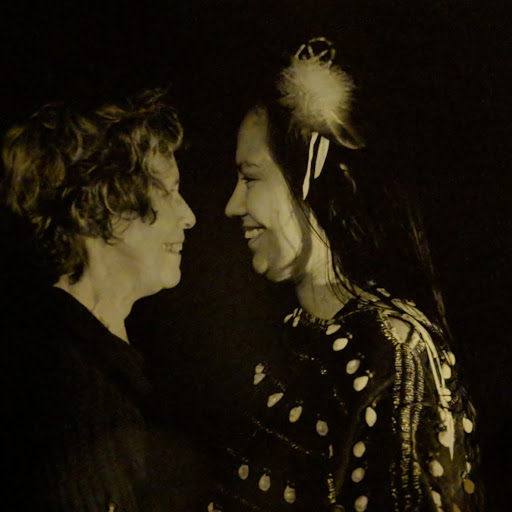
Eye-to-eye, seeing/not seeing, 2019. Mural photographic print on resin-coated paper. (Collection of Thompson Rivers University)
On September 1st 1990, Shaney Komulainen took a photograph of Anishinaabe defender, Brad Laroque, and Canadian Army soldier, Patrick Cloutier, standing face-to-face, which became an iconic representation of the crisis at the Kanehsatà:ke Reserve near Oka, Quebec. The photograph depicts two men in angry confrontation, each appearing to be a warrior for his own nation. In her analysis of this image, Rima Wilkes has pointed out the colonialism implicit in its misrepresentation of the struggle: Pte. Cloutier appears vulnerable by virtue of his “baby-faced” appearance and smaller stature, as well as the photographic invisibility of his weapon, while Laroque’s height and the visibility of his weapon present him as the aggressor. In fact, Cloutier was one of 800 armed military personnel supported by tanks and reconnaissance aircraft against a few dozen Mohawks and supporters. The cause of the confrontation: Mohawk defense of an ancestral burial ground against expansion of a golf course.
My attention was drawn to the men’s aggressive expressions and postures that suggest the imminent use of force. There had been violence and a fatality; Cpl. Marcel Lemay died in a firefight when the Sûreté de Quebec attempted to dismantle the initial barricades against the golf course development. An unarmed Mohawk girl, Waneek Horn-Miller was stabbed in the chest by a soldier’s bayonet as she walked out in peace on the last day. I had heard that indigenous women elders prevented violence during the stand-off by walking between the soldiers and the besieged “warrriors”, and I wondered how differently such a confrontation would have played out if women simply met face-to-face to negotiate issues. This is not meant as a simple-minded suggestion that women will always act as peace-keepers and negotiators, however; I clearly recall Margaret Thatcher chastising her CBC interviewer with, “My dear Mr. Gzowski, you don’t negotiate with terrorists!”
For me, the underlying issue is reconciliation, the true reconciliation that occurs in every moment of open encounter between two individuals who embrace one another in their full humanity. In that encounter, each person standing large calls out to others to join together.In contrast to the armed hostility suggested in the image above, we greet each other without weapons, but with warmth, acceptance and joy. I chose to make this image large because the issues layered within it are large: colonialism; the assault on indigenous culture and its renaissance; conflict prevention and resolution; and reconciliation after wrongs have been done. As Susan Stewart has pointed out, when we gaze upon a huge, yet intimate image we may be enfolded into the experience of the subjects – gazing at each other, each relinquishing control over the other.
We need to recognize, too, that if this is one face of reconciliation, there is another, more potent: two such women holding one another, weeping in response to the pain and horror inflicted by one culture on another – not only in the past, but here and now, in all times and places.
Lyn Richards, in response to Shaney Komulainen’s photograph, Face to Face, 1990, and in collaboration with Elizabeth Spike and Pete Smith. 2020 February 14
The Long Stare
Pete Smith, 1990/2020
Dawn in the pine woods
weaves its light
into a tapestry
older than nations.
Warriors and soldiers
eye to eye seeing
not seeing.
Kahnawake, Kanehsatake:
their consonants trip
my colonial tongue.
From the TV set
war cries whoop,
encircle those who hear
barked orders echo.
The future at a loss.
Once the Iroquois
Confederacy of Five Nations
showed Jefferson
how it was done.
In The Pines now
a battle of wills.
Baby-faced white private
uniformed by his young country;
soft-spoken Anishinaabe man
clothed in long tradition.
A clan mother walks between
before they settle into the long stare.
Fierce that no blood spill,
she walks a raw nerve
into the nations’ heart.
Who blinks matters nothing.
It’s this: what people, what kind
will step out from the pines?
To make what kind of world?
Dusk in the pine woods
weaves its dark
into a tapestry
older than nations.